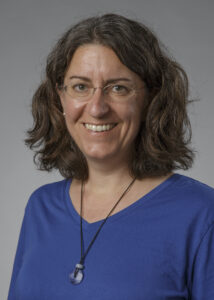‘Nutrition: Food and Fads’ is a Staple Among J-Term Courses
On the list of January Term courses, Alison J. Draper‘s “Nutrition: Food and Fads” is a regular. Draper, director of the Center for Interdisciplinary Science at Trinity College, has been teaching it –with a few exceptions – for about a decade. The J-Term course explores aspects of nutrition, including the science of food and popular diet plans. Students develop diet plans for themselves, follow them, and reflect on the experiences. So what makes a successful plan?

How have the food fads changed throughout the time you’ve been teaching this course?
I find that most students are interested in eating better, but few know where to start. Moving past all the hype and learning something about the science of nutrition helps. In some ways, food fads have changed a lot in this decade – from South Beach and Atkins diets, to miracle-cures and superfoods – but the skepticism with which students view all these interventions and the limited efficacy of these fads have remained constant.
What is your reaction to the latest fad, the ‘secret’ celebrity weight loss drug, and your reaction to medication for weight loss, in general?
In my course, I talk about these as short-cuts – in other words, short-duration drastic things one can do to lose weight or regain health quickly, but these are seldom a long-term healthy way to live. Except for someone in a dire health condition, weight loss medications and ‘secret’ drugs aren’t necessary. When a person switches to a super-healthy diet, health conditions resolve and weight drops off quickly. I’ve seen students transform in just a semester once they know what to do. I don’t mean to make it sound easy. Changing habits, breaking food addictions, and addressing the myriad emotional aspects of eating are really hard. But anyone can do it.
What surprises students as they learn about nutrition?
There are two things. First, students are surprised at how straightforward healthy eating is once you cut through all the hype and that healthy eating can also be tasty and satisfying.
Second, students are surprised to realize that in the U.S., there is no entity effectively looking out for their health. Food corporations are out to sell more food, and they prepare foods in a way that hijack our brains with sugar, fat and salt and make us want more. The USDA, which sets dietary guidelines, also promotes American agriculture, including strong support for meat, dairy, and eggs. The health care system treats our illnesses, but seldom focuses on the preventive care and lifestyle habits that would help us avoid many illnesses in the first place. They’re surprised to find that their health is in their own hands.
One of your assignments is to have students create a diet plan. What is the biggest challenge for them in developing that plan?
The main challenge is knowing where to start. How can you tell if a food is healthy? How do you know how much you need – how many calories, how much protein? Do you need any fat? Are carbohydrates bad? Once we get past all that basic information, figuring out what they need and coming up with a plan isn’t so hard. Sometimes I remind students that nutrition is a lab course – and they are the lab!
Talking to someone who teaches about nutrition always begs the obvious question: What type of eater are you?
Students always ask me this, and I avoid answering until the end of the course! I eat a whole-food plant-based diet. In other words, it’s uber-vegan – only plants, and only as they grow, so nothing processed: no white flour, sugar, added oils, etc. I’m not a purist – I eat this way for health reasons, and I don’t suggest that students have to follow my lead. I often say in class that for me, as a middle-aged and mostly-sedentary person, my needs are different than theirs! But I do walk students through the data about what different styles of eating beget in terms of health and longevity. I guess I talk a lot about longevity! It’s interesting to me as a middle-aged person, and I wonder if it resonates with students! Luckily enough, the same kind of healthy eating that leads to better longevity, my interest, also leads to better athletic performance, skin condition, and mental health outcomes, which are generally the top student interests.

You cook with the students as part of this course. Can you share one of your favorite class-selected recipes from the past?
Egyptian Red Lentil Soup is something I eat all winter – it heats up nicely for lunch and it’s just packed with nutrition. I made it for my class last spring and it won great accolades even from students whose own eating was as far from this as you can imagine. The highlight for me, though, was that the student in the class who was from Egypt said that it tasted like something her grandmother would make!
